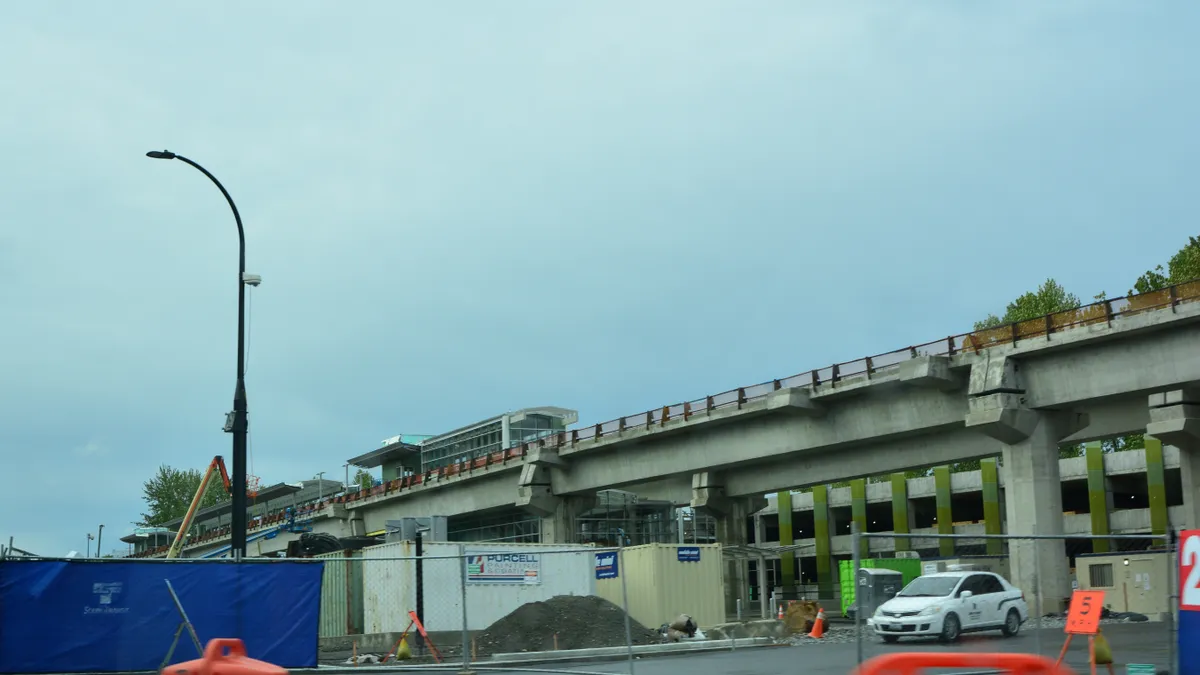Dive Brief:
- A slew of issues have delayed construction on the $10 billion Sound Transit expansion project, which will eventually extend light rail service from Seattle to western Washington state.
- The problems include a monthslong local concrete workers strike, pandemic-related delays, a collapsed embankment and issues with track supports that the contractors, a Kiewit-Hoffman joint venture, installed, according to a Sound Transit memo.
- As a result, four extension openings could be held up for months or over a year. “While it is too early to accurately assess the resulting construction delay, we now expect the project completion to extend some number of months into 2025,” Sound Transit said in the memo.
Dive Insight:
Sound Transit said in the memo that the 14-mile East Link, the most complex portion of the project, could see the longest delay of at least a year. The segment involves the world’s first effort to build and operate rail across a floating bridge, according to the agency.
Problems on the line began in 2019, when inspectors discovered that the top surface of some concrete plinths did not connect with the rails they were intended to support. Kiewit-Hoffman installed mortar between the blocks and the rails, but that mortar failed.
During work to fix that problem, the team discovered additional issues with concrete placements, according to the memo, which laid some of the blame for the issues on Kiewit-Hoffmann. Sound Transit board members in April approved a $15 million contract increase to Dallas-based Jacobs, which is providing construction management services on the East Link project, for months more than planned, according to the Seattle Times.
“Where there are construction quality issues, the contractor is performing the repair work at its cost. Where there are spillover issues that entail costs for other contractors or Sound Transit, their resolution will be negotiated,” the memo reads.
In addition, the Redmond extension has also run into several challenges related to power for the light rail system.
Concrete strike, pandemic contributed to delays
While some construction errors could have been mitigated, Sound Transit also pointed to factors outside of contractors’ and the agency’s control.
A Seattle-area concrete delivery strike began to significantly impact construction in King County starting in December 2021, Sound Transit said in the memo. The 330 Teamsters Local 174 union workers returned to work in April without winning better wages and healthcare benefits, but the resulting snarls to construction activity in the region are ongoing.
“The strike created additional challenges on top of the COVID-19 pandemic’s project delays, workforce impacts and supply chain issues,” Sound Transit’s memo reads. “In many cases, these challenges compounded others related to our contractors’ work, project designs and/or project oversight.”
Difficulties finding workers with transit project experience, inflation and other pandemic-related challenges also contributed to delays on the lines, the agency said.
Plus, the agency is trying to figure out how to work around unstable soil along the alignment between Kent and Federal Way. On July 19, a 200-foot section of embankment slid 9 feet and forced a partial closure of Interstate 5. Sound Transit said it has been temporarily stabilized but a new approach may be needed for that section of the light rail.
What’s next for the project
Currently, Sound Transit operates 26 miles of light rail with 25 stations, and it’s in the process of more than doubling the Link system to 62 miles and 50 stations by 2025, accounting for the estimates of the new delays.
Despite the delays, Sound Transit Deputy Director Kimberly Farley said in a meeting on Aug. 18 she’s confident in the project designs and that there’s no doubt that the lines will be built — albeit more slowly than anticipated.
“Sound Transit has a strong track record of completing major light rail construction on or ahead of schedule. However, the complex nature of our work to open these current segments, especially East Link, requires solving challenges that surpass what we’ve encountered with our previously completed projects,” said Farley in the memo.
The agency’s construction update didn’t come with new cost estimates, but the agency said in the memo it will be able to share more information by the fourth quarter of 2022 after it completes an assessment of the project.













